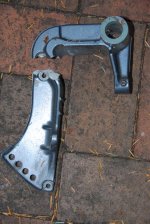G Gallagher
New member
Had a trailer it in down position--n interesting and expensive experience last week.
Have been trailering with motors tilted up. My Suzuki manual says don't do that,-- but sometimes I don't listen well. Suzuki is OK- my story is with the 2005 Yamaha 8hp kicker.
Trailered it in tilt position for about a year, but 2 weeks ago I went over a little bump and Oh,Oh. Motor flipped up a little and came back down shearing off the little nubs on the motor bracket that holds motor to transom. Now motor works well but no longer stays tilted up. Ok, into the dealer for the new- order new transom brakets. Parts came in after a week and the bill was $ 563.00 including labor, half the cost of the motor when I bought it.
I think it is fair to say don't trailer with tilted motor!!
Oh, one more lesson.-- With 4 cycle Yamaha if you lay motor down be certain that you do it with the tiller down. If you don't the oil will drain into the cylinders causing the motor to seize up. To fix that re-hang motor, pull plugs, clean them, squirt starter fluid in multiple times until oil is washed out, replace plugs and work to start motor.
What a fun week.
Gary
Have been trailering with motors tilted up. My Suzuki manual says don't do that,-- but sometimes I don't listen well. Suzuki is OK- my story is with the 2005 Yamaha 8hp kicker.
Trailered it in tilt position for about a year, but 2 weeks ago I went over a little bump and Oh,Oh. Motor flipped up a little and came back down shearing off the little nubs on the motor bracket that holds motor to transom. Now motor works well but no longer stays tilted up. Ok, into the dealer for the new- order new transom brakets. Parts came in after a week and the bill was $ 563.00 including labor, half the cost of the motor when I bought it.
I think it is fair to say don't trailer with tilted motor!!
Oh, one more lesson.-- With 4 cycle Yamaha if you lay motor down be certain that you do it with the tiller down. If you don't the oil will drain into the cylinders causing the motor to seize up. To fix that re-hang motor, pull plugs, clean them, squirt starter fluid in multiple times until oil is washed out, replace plugs and work to start motor.
What a fun week.
Gary


